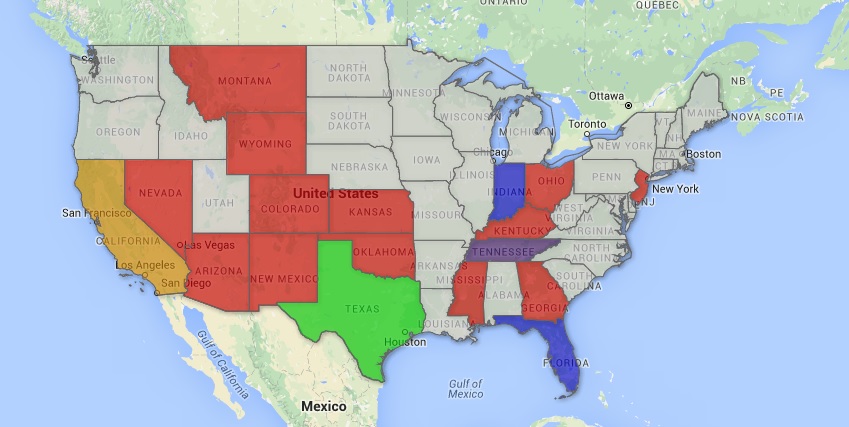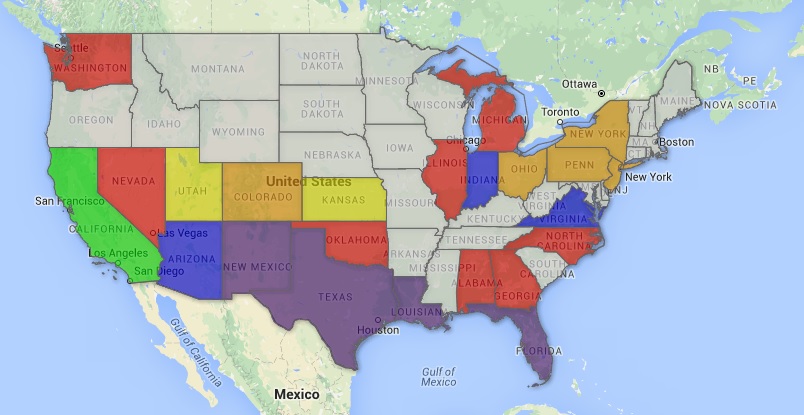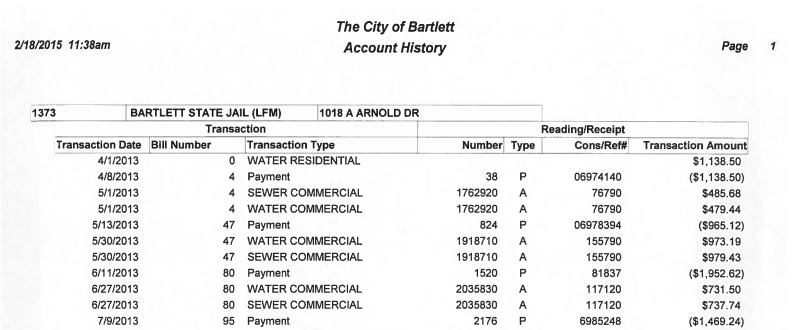Read Part 1 here
With combined revenues of over $3 billion dollars, it’s easy enough to point to GEO Group and CCA as fueling the private incarceration industry. But between their prisons, jails, immigrant detention centers, youth residential centers, and community corrections facilities, there are now 151 communities complicit across the country, including places like Florence or Sayre, where local cooperation has been necessary to the expansion of private prisons.

States with contracts with CCA

States with contracts with GEO
- Yellow = leased only
- Blue = facility managed
- Red = facility owned/operated
- Green = facilities owned, managed, and leased
- Purple = facilities both owned/operated and managed
Consider, for example, cases of emergency in which the police or an ambulance might be called, situations from trespassing on the property to full-scale riots. Many private facilities require an agreement with local law enforcement before they begin operations, ensuring that they’ll respond if need be.

It may seem like a straightforward ask - after all, one expects that the cops come when called. But the number of times a department has to make good on that can vary widely, depending on things like how well-managed the place is or whether there are parties interested in getting contraband across the perimeter.

It’s a fringe cost and inconvenience typically unconsidered, because it’s part of the infrastructure we might take for granted, just like water and sewage systems, or other upgrades from the city, like roads to access the facilities. As we mentioned in Part One, a lot of times the infrastructure necessary for a prison, including things like waste disposal, depends on the town, and successful attempts at expansion depend, in part, on the town’s willingness to keep the infrastructure in line with the projected growth.

These sorts of fringe costs, though, can seemingly pale in comparison to the financial benefits a town is agreeing to when they sign on the dotted line.

Firstly, the creation of new jobs can be particularly attractive to a depressed area. It’s not uncommon to see agreements to fill X percent of jobs with local hires - in Sayre, for example, their unemployment rate dropped to practically negligible.
As important as that can be for an area, however, it also reveals a bit of the underbelly of that success: an obvious lack of other jobs and seeming dependency on a single entity. It’s clearly a precarious position for any area to be in, which, of course, is part of the appeal of a partnership for both parties. Private prisons are known for general staffing shortages and notoriously high turnover, in part due to an inability to staff qualified officers in some areas and the general difficulty of the job.

But while the quality of employment is up for discussion, the expected revenue from those jobs, if filled, is less uncertain.
Taxes and fees that towns and counties receive can form an important part of the municipal budget. Beyond the costs of providing water and sewage, construction fees and other permits generate extra dough. Property taxes, too, can provide a huge, reliable source of revenue, even if the prison is closed.
For many towns, there is also the added benefit of a flat fee or per inmate commission for the prison enrollment, one of the clearest ways that a company can ensure that the city’s interests are aligning with their own.
As discussed before, IGSAs between the town and another government entity are managed with the benefit of an administrative fee, which can reach as much as $15,000 a month.

Other places, like in Colorado, rely on a 2 dollar-a-day kickback.

The economic impetus of these prisons is made particularly clear in areas where whole subdivisions assist with establishing the relationship, like in Louisiana at the LaSalle Economic Development District.
And they’re made even more curious by regular company perks, like the annual steak luncheon held in Eden, Texas …

and savings from inmate labor.
When weighing the tangible benefits against the intangible effects, it’s hard to see symptoms of an ailing society for all the dollar signs. It’s why places like California City cycle through customers, just as Sayre did, and why Pine Prairie responded to bids that weren’t even relevant to their state.

It’s also part of why it’s so alarming when records are held confidentially by the town, part of what raises flags when employees in these areas are encouraged to buy stock in the companies, compounding the incentive to keep the prison open, operating, and free of scandal, and part of why dozens and dozens of cities have bought into the prison pie.
And what if the prison can’t stay open?

Well, it’s part of what you see in Sayre, which the Oklahoma government recently granted a sort of reprieve when they agreed to lease the empty building.

Others are less fortunate, like the swath of Texas towns left defaulting on their loans, and other cities, like Kingman, AZ and Winnfield, LA that must also depend on the state to keep their investment open and afloat.
But dozens of other towns have said no to such an alliance, avoiding the maelstrom of misincentives, despite the sales pitch and the sort of optimism places like Florence give to towns wanting to get into the industry. Americans continuing to grapple with how to treat crime in this country, it’s important to consider the economic voids that are acting allies in the spread of private prisons.
- Corrections Corporation - Red
- GEO Group - Blue
- Management and Training Corporation - Green
Are you a journalist, activist, or otherwise concerned citizen living near or in a state with private prisons? Have you heard a story about private prisons that you find unsettling? Reach out and let us know.
Image via SignsOfArizona.com




